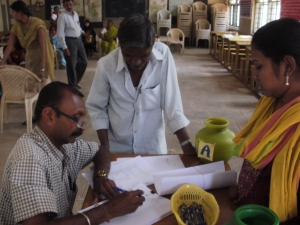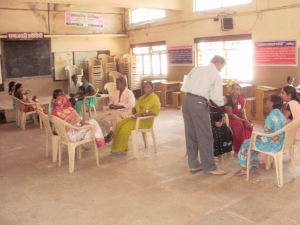Posted by Jaideep Gupte
 ‘Communal violence’, as ethnic riots are termed in South Asia, is one of the major types of violence in evidence in the region today. Not only is it endemic and recurrent in ‘flash-point’ parts of the region, it is also wide spread. Data shows India experienced an average of over 64,000 riots[1] per year over the last decade, while 16 out of 28 of its states experienced more than 1000 riots in 2010.[2] In Maharashtra, where our panel study[3] is based, riots were initially infrequent, increasing drastically during the late 1970s, peaking in the early 1980s and have since remained at a high level of approximately 6000 riots per year spread across the state. Furthermore, while rioting has consistently fallen since the 1990s across India, Maharashtra stands as an exception.
‘Communal violence’, as ethnic riots are termed in South Asia, is one of the major types of violence in evidence in the region today. Not only is it endemic and recurrent in ‘flash-point’ parts of the region, it is also wide spread. Data shows India experienced an average of over 64,000 riots[1] per year over the last decade, while 16 out of 28 of its states experienced more than 1000 riots in 2010.[2] In Maharashtra, where our panel study[3] is based, riots were initially infrequent, increasing drastically during the late 1970s, peaking in the early 1980s and have since remained at a high level of approximately 6000 riots per year spread across the state. Furthermore, while rioting has consistently fallen since the 1990s across India, Maharashtra stands as an exception.
The North-eastern state of Assam, virtually at the other end of India’s expanse from Maharashtra, is currently in the news as rioting there has killed over 50 in the past few days.[4] The media has been quick to latch on to the ‘communal’ nature of the violence, describing the violence as between Hindus and Muslims. But this categorisation has been conflated with a variety of explanations, ranging from having religious to political underpinnings, and even to issues of illegal immigration of Bangladeshi’s into the region. These categorisations all share some degree of truth. The region shares a very porous border with Bangladesh, with scores migrating seasonally (and illegally) into India in search of employment. A large number are also permanently settled in India, and remit earnings to Bangladesh. This situation has given the media ample cause to portray the current violence as between immigrants and the local Boro community, who are involved in their own struggle with Delhi for autonomy in the Boro Territorial Autonomous District (BTAD).
However, our research on rioting in India underlines that communal and ethnic categorisations are incomplete (see MICROCON Working Paper 62).[5] They do not fully capture the processes of perpetration, impacts or mitigation of the violence. There are five reasons for this: (1) First and foremost, is that the term ‘communal violence’ has been derived out of an imprecise historical usage – an argument persuasively put forward by Gyan Pandey.[6] The term was coined during colonial times to refer to local groupings, the nature of which the colonial presence failed to fully understand. (2) is that the terms ‘communal’ or ‘ethnic’ imply the violence is at a large scale, between entire communities or ethnicities. This hides the immensely destructive potential of smaller bouts of rioting, which can completely re-order day-to-day normality. (3) is that a wide variety of groups and actors are involved in bouts of rioting, and not all of these can be classified as communal or ethnic. Hindu-Muslim riots have also involved tribal communities (in Gujarat, for example), while the police have often been directly involved in the perpetration of violence around episodes of rioting. (4) is that women and men experience riots in varied ways, the nuances of which cannot be generalized by associating one gender with ‘the victims’ and the other with ‘the perpetrators’. Women are just as likely to perpetrate violence, as they are likely to be involved in its mitigation. Importantly, synergies and parallels between the experiences of women and men across ‘communities’ are often far stronger than those within communities. And (5) is that individual characteristics are crucial in determining how and by whom riots are perpetrated and experienced. A person physically perpetrates violence in public for a wide variety of reasons, not all of which are clearly understood through communal or ethnic framings. In my research I find that rioting often involves ‘dispossessed’ individuals, who partake in public riots to showcase individual strength.[7]
Understanding household vulnerability to violence
So how might vulnerability to such violence be accurately understood? In Maharashtra, where we’re studying 45 riot-prone neighbourhoods across nine districts, one of the significant factors is where the violence is perpetrated and experienced in relation to a number of local spatial characteristics, measured by what I term as ‘micro-distances’. I have not been able to find a more appropriate term in the literature to describe the small distances which individuals cover in no more than a few minutes by foot in their day-to-day lives – walking on the footpath, going to the market, school or neighbours house, for example (if there is a more appropriate term already in the literature, please point me in the right direction!). Indeed, I would argue that this kind of information, which describes each respondent household through a plethora of spatial information, would be an important addition to any household survey on poverty and vulnerability. Some surveys tend to retrospectively locate households by matching or comparing addresses. As I have explained in a previous blog however (Attrition: the scourge of tracing), this is not an easy task – ‘fourth house from well’ could be right next to ‘house near to temple’. As social animals, how we interact with our surroundings and how our surroundings impact upon us are important in defining who we are and arguably, have a bearing on our development outcomes. Spatial information locates households within this space, and allows additional levels at which household data points can be interacted with one another.
Are micro-distances important and significant?
We find that they are. For example, how perpetrators, victims and witnesses relate with their belligerent neighbour, live in a dark alley way, are affected by a faulty water pipeline, or live far from public toilets, adds values to our understanding of riots which cover much larger areas. These distances not only help characterise vulnerability of secluded or peripheral households, but also help identify important nuances of vulnerabilities faced right across the spaces in which violence occurs. Preliminary analysis of spatial data from our sample neighbourhoods reveals that even though sustaining physical injury to person or damage to one’s property is a rare event during a riot, with only 0.03% of households in our sample falling under this ‘acute’ category (even though over 71% of our survey sites were affected by at least one riot), almost all such victims live within a 5-minute walk of another acute victim. In the adjoining picture, I show this pictorially for 14 of our survey sites. The maps shows a variety of data including roads/pathways, waterways, open spaces/gardens, bridges, police stations, schools, markets, clinics and gyms to name a few. Acute victims are plotted as red hexagons, and a 2.5-minute perimeter is highlighted in orange around each of them. Overlapping perimeters indicate that acute victims are within 5-minutes of one another. If we had not collected spatial information, it would not have been possible to locate vulnerability in this precise manner.
This preliminary result suggests that violence in riots that are purportedly ‘organic’, erupting suddenly as a result of long standing friction between communities, is in fact not singular or monotone. But it is formed of more complex events where violence is perpetrated at multiple levels, involving more brutal acts as well as minor offences. In Assam, it cannot be doubted that (illegal) immigrants are present and involved in the violence, neither can it be doubted that there are local groups who are already mobilised over a struggle to be autonomous. However, local scholars who have engaged with the under-currents leading up to the violence find “this tendency to conflate conflicts into easily identifiable ethnic constituencies simplistic, leaving little scope for either understanding or intervention”.[8] Because this violence so deeply affects already strained livelihood strategies, further (read long-term) research will undoubtedly reveal that issues of authority and legitimacy – at the individual level – are at the core of the violence. By this I mean that in situations where individuals feel economically, politically and socially dispossessed, being publically violent is an extremely effective strategy to showcase one’s capacity to provide for one’s household. Using micro-distances as I have suggested above, or other more locally specific micro-level analyses, is key in accurately understanding the vulnerabilities that directly and indirectly impact upon the individuals that perpetrate and experience riots. To this end, they can also explain much about why riots occur when and where they do, and importantly, who participates in them and why.
[1] Defined loosely under Section 146 of the Indian Penal Code as “Whenever force or violence is used by an unlawful assembly, or by any member thereof, in prosecution of the common object of such assembly, every member of such assembly is guilty of the offence of rioting.”
[2] Crime In India, various years. New Delhi: National Crime Records Bureau, Ministry of Home Affairs, Government of India.
[3] With Patricia Justino and Jean-Pierre Tranchant. Funded by the European Commission (www.microconflict.eu) and the DFID-ESRC (“Agency and Governance in Contexts of Civil Conflict” http://www.esrc.ac.uk/my-esrc/grants/RES-167-25-0481/read).
[4] http://www.expressindia.com/latest-news/pm-visits-violencehit-kokrajhar-says-restoring-peace-top-priority/980669/
[5] Gupte, J. 2012. What’s civil about intergroup violence? Five inadequacies of communal and ethnic constructs of urban riots. MICROCON Research Working Paper 62, Brighton: MICROCON
[6] Pandey, Gyanendra. 1990. The Construction of Communalism in Colonial North India. New York: Oxford University Press.
[7] Gupte, Jaideep. 2011. “Extralegal security and policing for the urban dispossessed in Mumbai.” In Urbanizing Citizenship: Contested Spaces in Indian Cities, eds. R Desai and R Sanyal. New Delhi: Sage.
[8] Barbora, Sanjay. 2012. “Identity of a recurring conflict.” The Hindu, July 31st. Available from http://www.thehindu.com/opinion/lead/article3704450.ece?homepage=true (Accessed on 31/07/2012).

















